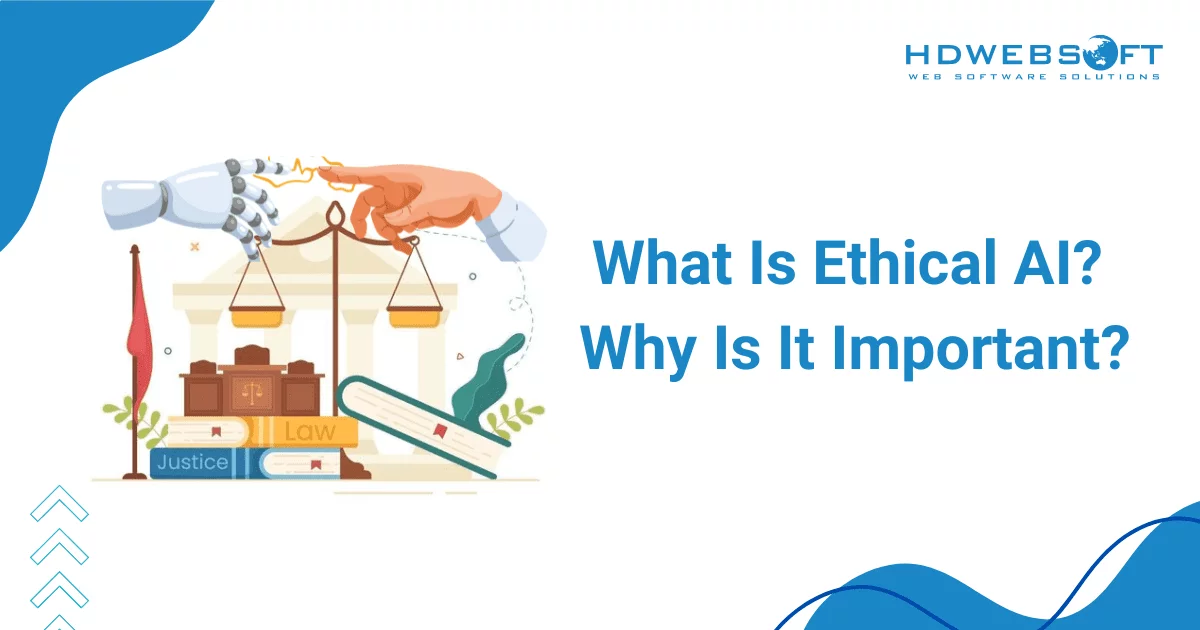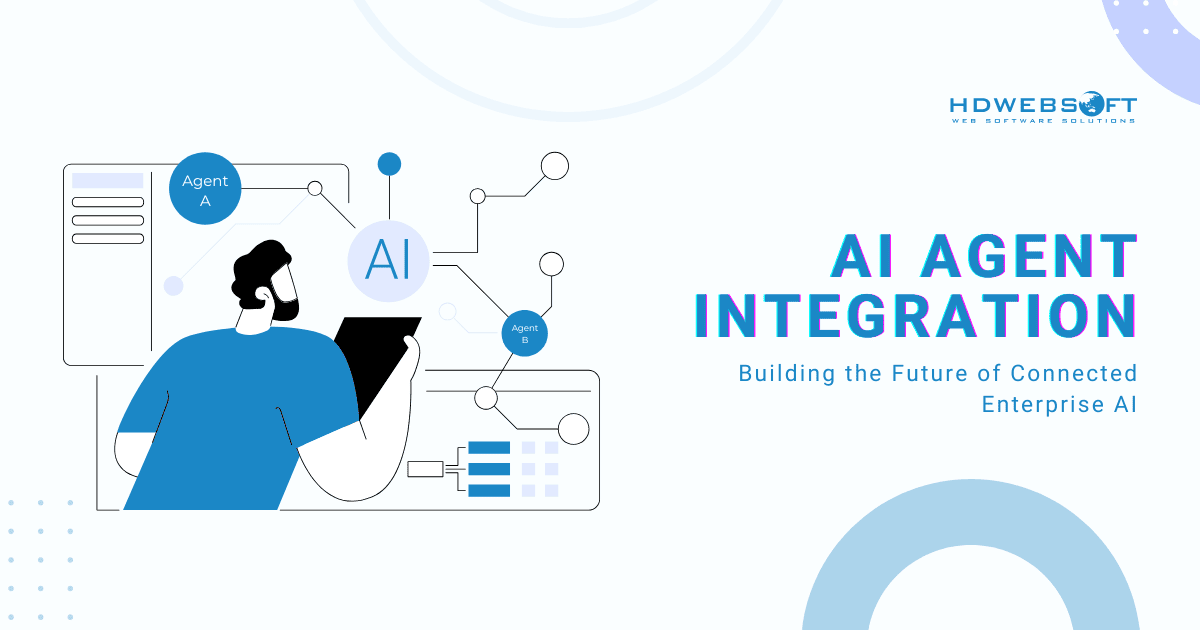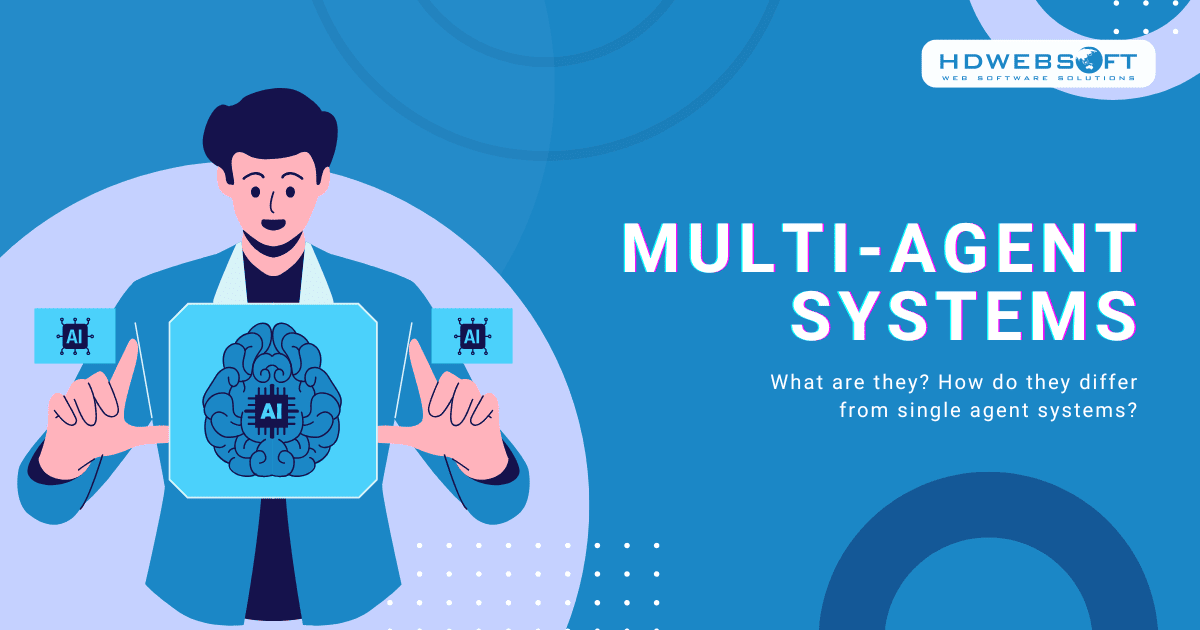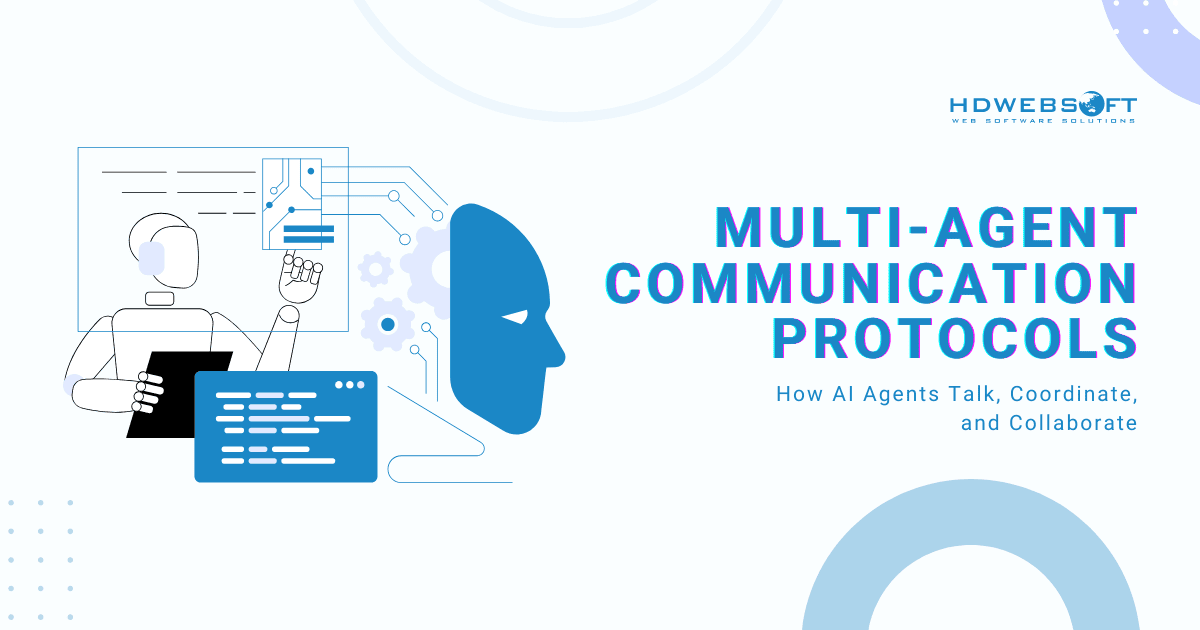
Multi-Agent Communication Protocols: How AI Agents Talk, Coordinate, and Collaborate
Multi-agent communication protocols serve as the backbone for enabling seamless interactions between autonomous agents in distributed artificial intelligence systems. In the current time, businesses increasingly adopt multi-agent systems to handle complex workflows and decision-making processes. Hence, understanding how these intelligent entities communicate and coordinate becomes crucial for successful implementation.
This comprehensive guide explores the fundamental protocols that govern agent interactions. You’re also provided with the sophisticated agent coordination mechanisms that enable collective intelligence in modern enterprise environments.
- 1) Understanding Agent Communication Basics
- 2) Essential Multi-Agent Communication Protocols
- 3) Strategies for Multi-Agent Coordination
- 4) Technical Implementation Considerations
- 5) Security in Multi-Agent Communication Protocols
- 6) Performance Optimization
- 7) Best Practices and Implementation Guidelines
- 8) Conclusion
Understanding Agent Communication Basics
Effective communication forms the cornerstone of any successful implementation of inter-process communication. Unlike traditional software systems that rely on direct function calls, autonomous agents must exchange information across network boundaries. All the while, they need to maintain their independence and decision-making capabilities.
The complexity of these interactions increases exponentially as the number of participating agents grows. Therefore, it has become a standardized communication approach for ensuring system scalability and reliability.
Message Structure and Components
Understanding the anatomy of agent messages is crucial for implementing robust multi-agent communication protocols. Each message contains standardized components that enable agents developed by different vendors to interact seamlessly within the same network environment.
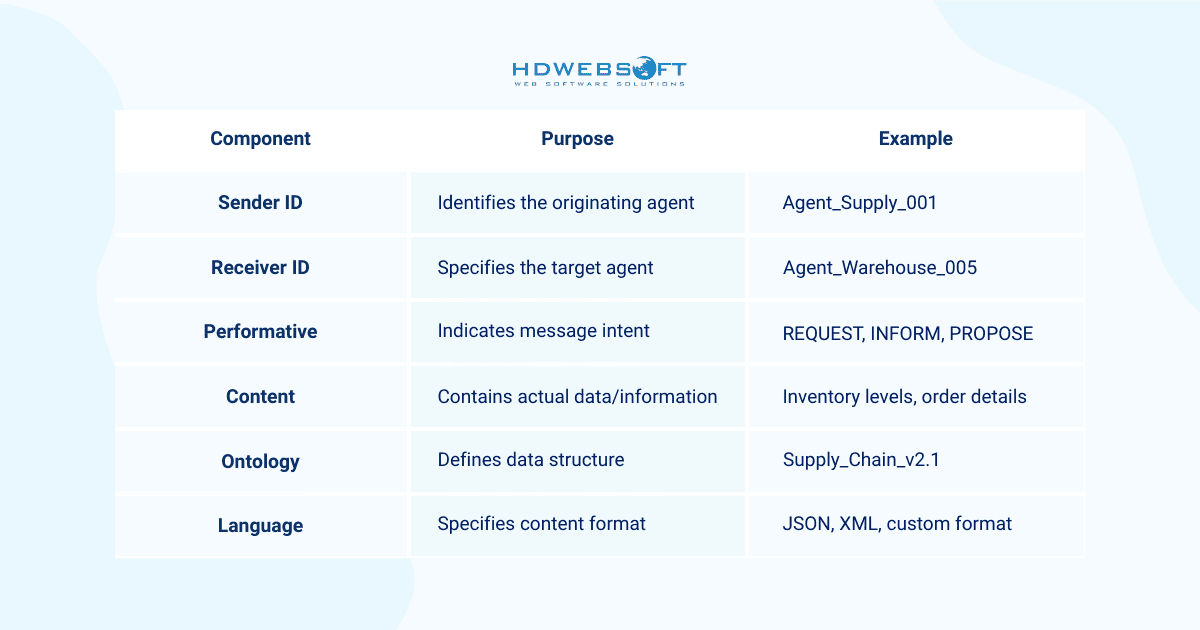
Without proper message structuring, agents would struggle to understand each other’s intentions and data formats. Ultimately, it leads to communication breakdowns and system failures.
Additional metadata
Beyond these core elements, advanced inter-process communication protocols often incorporate additional metadata that enhances processing efficiency:
- Timestamps: Enable temporal ordering and expiration handling for time-sensitive communications
- Priority levels: Ensure critical messages receive preferential treatment during network congestion
- Conversation identifiers: Maintain context across multiple message exchanges within complex negotiations
- Security tokens: Provide authentication and authorization for secure communication channels
- Reply-with fields: Link responses to original requests for proper conversation threading
- Encoding specifications: Define character sets and data formats for international compatibility
These supplementary components transform simple data exchange into sophisticated communication frameworks that support complex agent coordination mechanisms.
Communication Patterns in Multi-Agent Systems
Different operational scenarios require distinct multi-agent communication protocols. Each of them offers unique advantages and trade-offs in terms of performance, scalability, and reliability. Thus, selecting appropriate communication patterns significantly impacts overall system effectiveness and should align with specific use case requirements.
Common communication patterns
- Point-to-Point Communication: Direct messaging between two specific agents that provides efficient, low-latency information exchange. It’s ideal for private negotiations and confidential data sharing.
- Broadcast Communication: One agent sends identical messages to multiple recipients simultaneously, enabling rapid information dissemination for announcements and status updates.
- Publish-Subscribe: Agents subscribe to specific message types or topics, creating scalable information distribution that decouples message producers from consumers.
- Request-Response: Synchronous communication requiring immediate replies, ensuring reliable information exchange but introducing latency due to waiting periods.
- Event-Driven: Asynchronous messaging triggered by system events, providing excellent responsiveness to changes. Meanwhile, it requires careful event filtering to prevent information overload.
- Multicast: Selective broadcasting to specific agent groups based on roles or interests, balancing efficiency with targeted information delivery.
Each pattern serves different coordination needs within multi-agent communication protocols. Consequently, sophisticated systems often combine multiple patterns to optimize performance across various types of interactions.
Essential Multi-Agent Communication Protocols
Standardized protocols ensure interoperability and consistency across diverse agent implementations, reducing development complexity and enabling plug-and-play agent integration.
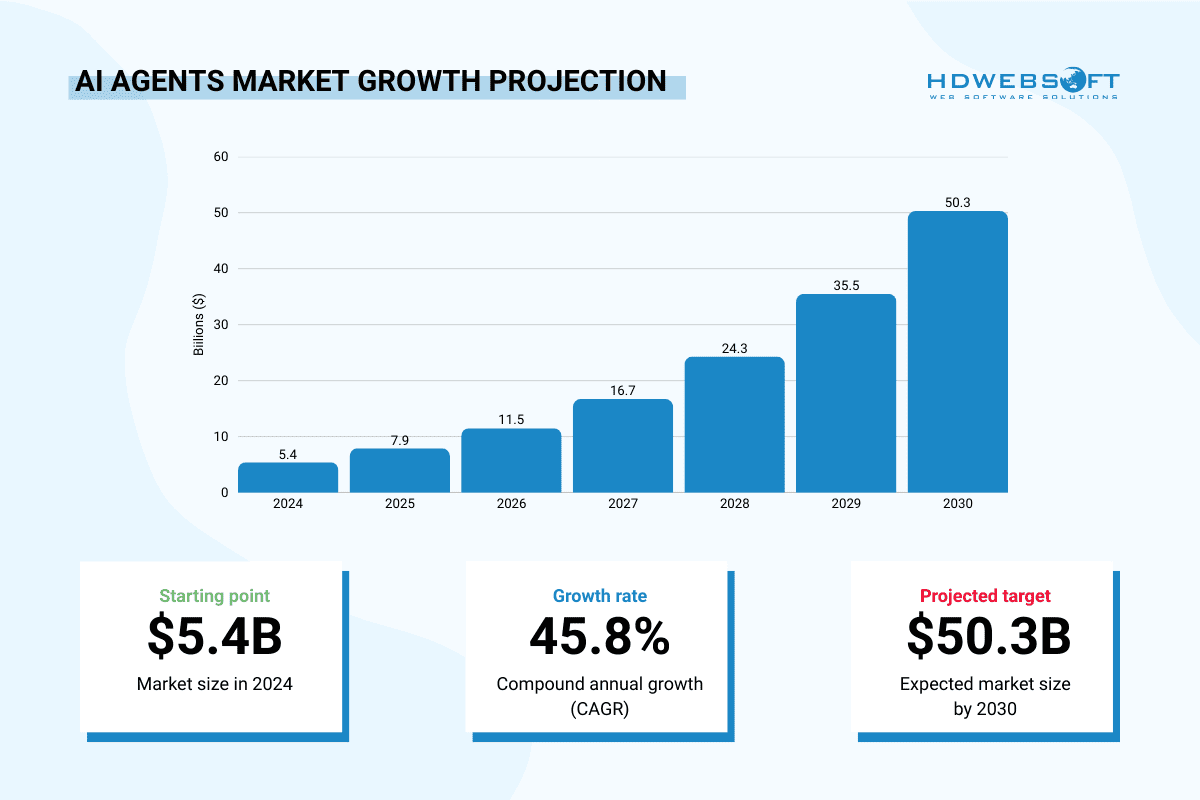
According to recent research, the global AI agents market size is projected to reach $50.31 billion by 2030, growing at a CAGR of 45.8%. The statistics underscore the crucial importance of establishing robust communication standards to support this rapid growth.
FIPA-ACL: The Industry Standard
The Foundation for Intelligent Physical Agents Agent Communication Language (FIPA-ACL) represents the most widely adopted standard for agent coordination mechanisms. This comprehensive framework defines both message structure and semantic meaning, enabling agents from different vendors to communicate effectively.
FIPA-ACL employs performatives, the standardized speech acts that convey the sender’s intention. These performatives in multi-agent communication protocols include:
- INFORM: Shares factual information with other agents without expecting specific actions, commonly used for status updates and data broadcasting.
- REQUEST: Asks another agent to perform a specific action, typically including details about desired outcomes, constraints, and deadlines.
- PROPOSE: Suggests courses of action or negotiation terms, often used in auction-based agent coordination mechanisms where agents compete for resources.
- ACCEPT-PROPOSAL: Agrees to previously received proposals, indicating commitment to specified terms and conditions.
- REJECT-PROPOSAL: Declines proposals with optional reasoning to help proposing agents understand decision factors and improve future offers.
- QUERY-REF: Requests specific information or data from other agents, enabling knowledge sharing and collaborative problem-solving.
- CONFIRM: Acknowledges receipt and understanding of previously received information, ensuring reliable communication completion.
- CANCEL: Withdraws previously sent requests or proposals, allowing agents to change their minds and adapt to evolving circumstances.
These performatives enable sophisticated multi-agent communication protocols that support complex negotiations, collaborative planning, and distributed decision-making processes. Moreover, FIPA-ACL’s semantic richness allows agents to engage in nuanced interactions that closely mirror human communication patterns.
Here, we’ve provided you with an example that makes the abstract FIPA-ACL message structure concrete and easier to understand. Take a look at this sample code. It’s an INFORM that asks the design agent to perform a specific task with detailed requirements and deadline constraints.
(inform
:sender materials-agent
:receiver design-agent
:content "((material-status steel-grade-a)
(availability 500-tons)
(delivery-date 2025-09-05))"
:language fipa-sl
:ontology manufacturing-ontology
:protocol fipa-inform
:conversation-id material-update-001
)Knowledge Query and Manipulation Language
While FIPA-ACL dominates modern implementations, Knowledge Query and Manipulation Language (KQML) continues serving specific use cases. In particular, it’s used in academic and research environments where its focus on knowledge representation proves valuable. KQML’s strength lies in its ability to handle complex knowledge queries and manipulations. As a result, it is suitable for expert systems and knowledge-based applications.
Key differences between these protocols include:
- KQML focus: Emphasizes knowledge representation and manipulation with rich ontological support for complex domain modeling.
- FIPA-ACL focus: Prioritizes practical communication efficiency with streamlined message structures optimized for operational deployments.
- Complexity trade-offs: KQML offers greater expressiveness at the cost of implementation complexity, while FIPA-ACL balances functionality with practical usability.
- Tool support: FIPA-ACL enjoys broader commercial tool support, while KQML maintains a strong academic research community backing.
Alternative Protocols
Additionally, many organizations develop custom multi-agent communication protocols tailored to their unique requirements. Particularly, custom protocols often prove necessary when:
- Existing standards cannot accommodate specific domain requirements
- Performance optimization demands specialized message formats
- Legacy system integration requires proprietary communication methods
- Security constraints necessitate encrypted or authenticated messaging
However, organizations must weigh the benefits of customization against the long-term maintenance costs and interoperability limitations.
Strategies for Multi-Agent Coordination
Beyond basic communication, sophisticated agent coordination mechanisms enable multiple autonomous agents to work together toward common goals. Meanwhile, they should manage potential conflicts and resource constraints. These coordination strategies transform collections of individual agents into cohesive systems. Those that are capable of solving complex problems that exceed the capabilities of any single agent.
Market-Based Coordination
Economic models offer powerful frameworks for inter-process communication, particularly in scenarios where multiple agents compete for limited resources or opportunities. Market-based approaches leverage competition and negotiation to achieve optimal outcomes while maintaining agent autonomy and decision-making independence.
Contract Net Protocol
The Contract Net Protocol represents one of the most successful market-based coordination strategies. It provides a structured framework for task delegation and resource allocation within multi-agent communication protocols. This approach proves especially effective in dynamic environments where agent capabilities and availability change frequently.
The protocol follows these systematic steps:
- Task Announcement: An agent broadcasts tasks requiring assistance, including detailed specifications, requirements, evaluation criteria, and deadline constraints.
- Bid Submission: Interested agents submit competitive proposals outlining their capabilities, availability, proposed terms, and quality guarantees.
- Bid Evaluation: The announcing agent evaluates received bids against predetermined criteria, considering factors such as cost, timeline, quality, and past performance history.
- Contract Award: The most suitable proposal receives the contract, with a clear specification of deliverables, timelines, and success metrics.
- Task Execution: The winning agent completes assigned work according to agreed specifications while providing regular progress updates and status reports.
- Performance Assessment: Completion triggers an evaluation of results and contractor performance, informing future selection decisions.
This structured approach ensures fair competition and, at the same time, maintains clear accountability throughout the coordination process.
Auction Mechanisms
Various auction formats enable different coordination strategies within multi-agent communication protocols, each optimized for specific scenarios and requirements. The choice of auction mechanism significantly impacts coordination effectiveness and should align with operational objectives:
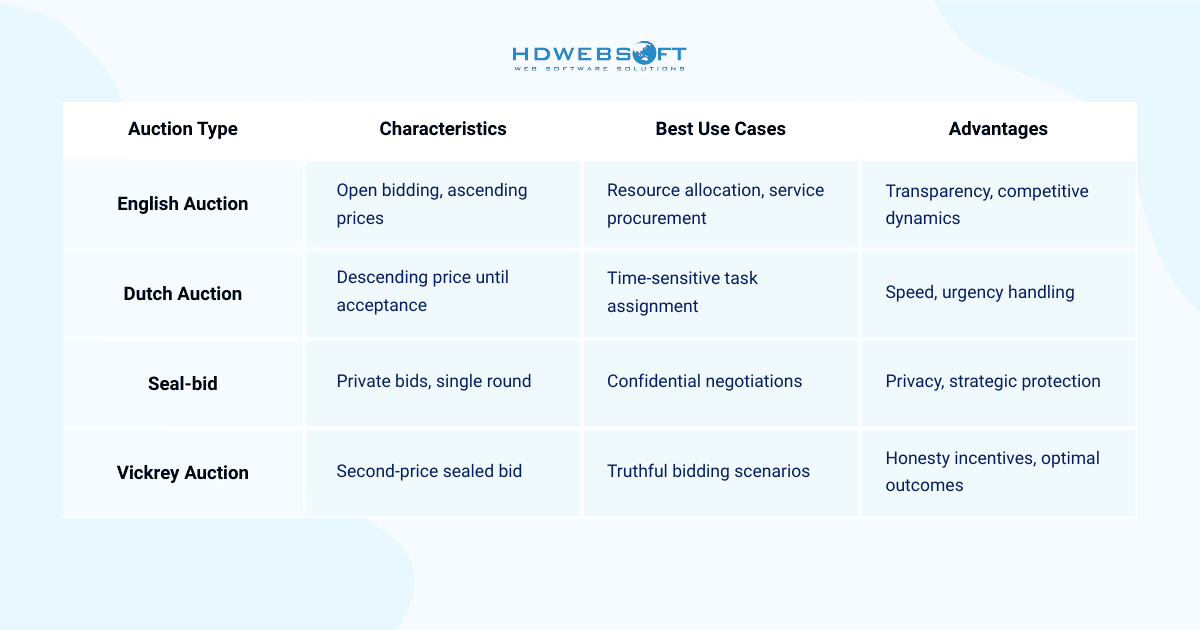
Consensus-Based Coordination
Consensus mechanisms ensure all participating agents agree on critical decisions. It’s particularly important for agent coordination mechanisms in distributed systems where consistency matters more than speed. These approaches prove essential in scenarios where incorrect decisions could’ve significant consequences or where all agents must maintain synchronized states.
Voting and Decision Aggregation
Democratic approaches to coordination allow agent collectives to make decisions through various voting mechanisms that balance individual agent preferences with collective outcomes. The selection of appropriate voting methods depends on decision importance, time constraints, and acceptable risk levels:
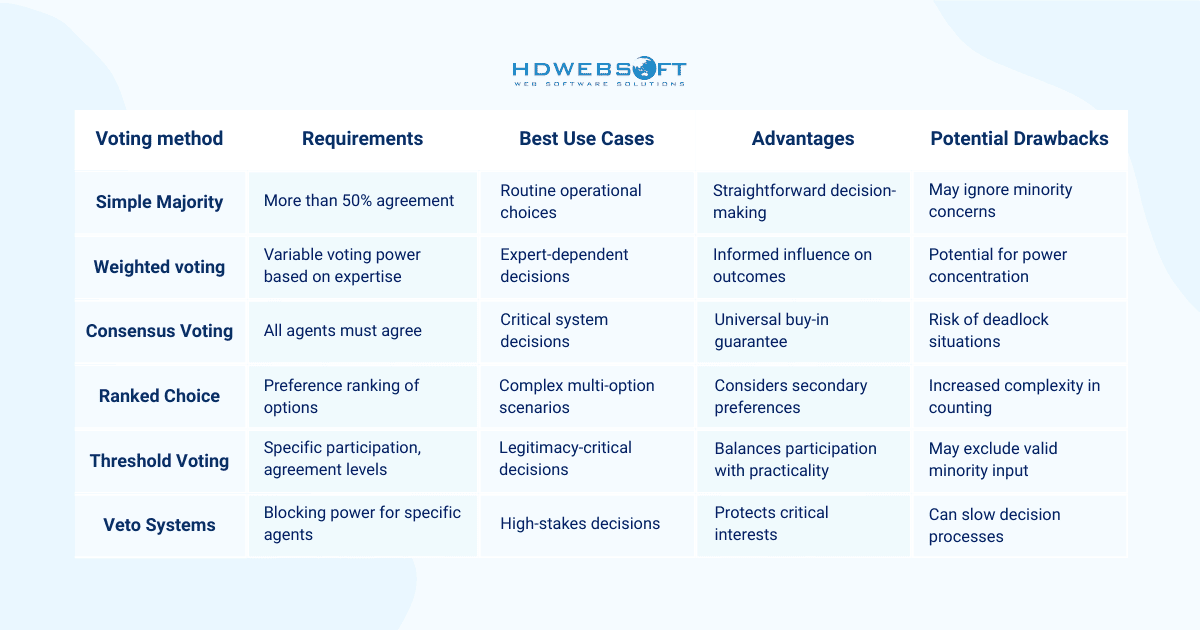
These voting mechanisms can be combined with various aggregation functions to handle ties, near-ties, and complex preference patterns. Moreover, sophisticated implementations incorporate reputation weighting, expertise scoring, and historical performance metrics to enhance the quality of decisions.
Byzantine Fault Tolerance
Robust multi-agent communication protocols must handle faulty or malicious agents that might provide incorrect information, behave unpredictably, or actively attempt to disrupt system operations. Byzantine fault tolerance algorithms ensure system integrity even when some agents fail or act maliciously. Ultimately, they maintain operational continuity despite partial system compromises.
Key Byzantine fault tolerance principles include:
- Redundancy Requirements: Systems typically require that fewer than one-third of participating agents exhibit faulty behavior to maintain reliable operation.
- Cross-Verification: Critical information receives independent verification from multiple sources before acceptance into decision-making processes.
- Consensus Mechanisms: Multiple agents must agree on important decisions before implementation, preventing single points of failure or manipulation.
- Detection Systems: Monitoring mechanisms identify suspicious behavior patterns and isolate potentially compromised agents.
- Recovery Procedures: Automated systems restore normal operation after detecting and addressing fault conditions.
Implementation involves redundant communication pathways, cross-verification of critical information, and consensus mechanisms that function despite conflicting inputs. Consequently, these approaches to multi-agent communication protocols necessarily increase communication overhead and computational complexity. However, they also provide essential reliability guarantees for mission-critical applications.
Hierarchical Coordination
Organizational structures provide another approach to agent coordination mechanisms. They are establishing clear authority relationships and decision-making hierarchies that mirror traditional organizational models. This coordination style proves particularly effective in scenarios that require centralized oversight and standardized procedures.
Hierarchical structures typically involve:
- Master Agents: Make high-level strategic decisions, set overall system goals, and allocate resources across organizational divisions
- Supervisor Agents: Coordinate specific operational areas, translate strategic directives into tactical plans, and monitor subordinate performance
- Worker Agents: Execute individual tasks, report status updates, and provide operational feedback to supervisory levels
- Coordinator Agents: Facilitate communication between hierarchy levels, manage information flow, and resolve inter-departmental conflicts
When Hierarchical Coordination Excels
Hierarchical structures prove most effective in specific operational environments:
- Clear Accountability Requirements: Systems needing traceable decision paths and responsibility chains for compliance, auditing, or error investigation.
- Multi-Source Information Integration: Scenarios requiring the synthesis of diverse data streams from multiple agents before making informed decisions.
- High Coordination Complexity: Situations where distributed coordination would create excessive overhead or fail to achieve optimal outcomes due to complexity. However, hierarchical structures can create bottlenecks at higher levels and may prove less adaptable to rapidly changing conditions than more distributed coordination mechanisms.
Technical Implementation Considerations
Successful deployment of multi-agent communication protocols requires careful attention to infrastructure, networking, and performance considerations. These technical factors often determine whether theoretical coordination mechanisms can be successfully deployed in real-world environments with practical constraints.
Network Architecture and Topology
The underlying network structure significantly impacts communication efficiency and system scalability. At the same time, different topologies offer distinct advantages depending on specific operational requirements.
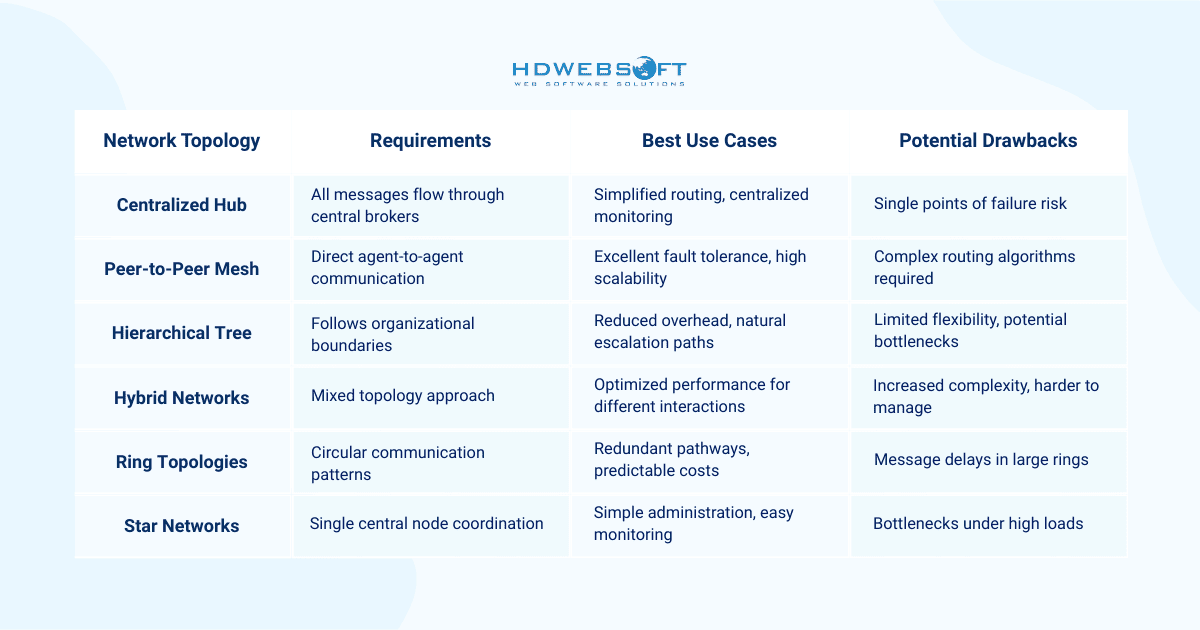
Architecture decisions made early in system design often prove difficult to change later, making careful initial planning essential.
Message Routing and Discovery
Effective agent coordination mechanisms rely on agents’ ability to locate and connect with relevant peers in dynamic environments where agent populations frequently change. Hence, discovery mechanisms must balance efficiency with reliability while accommodating various agent capabilities and network conditions.
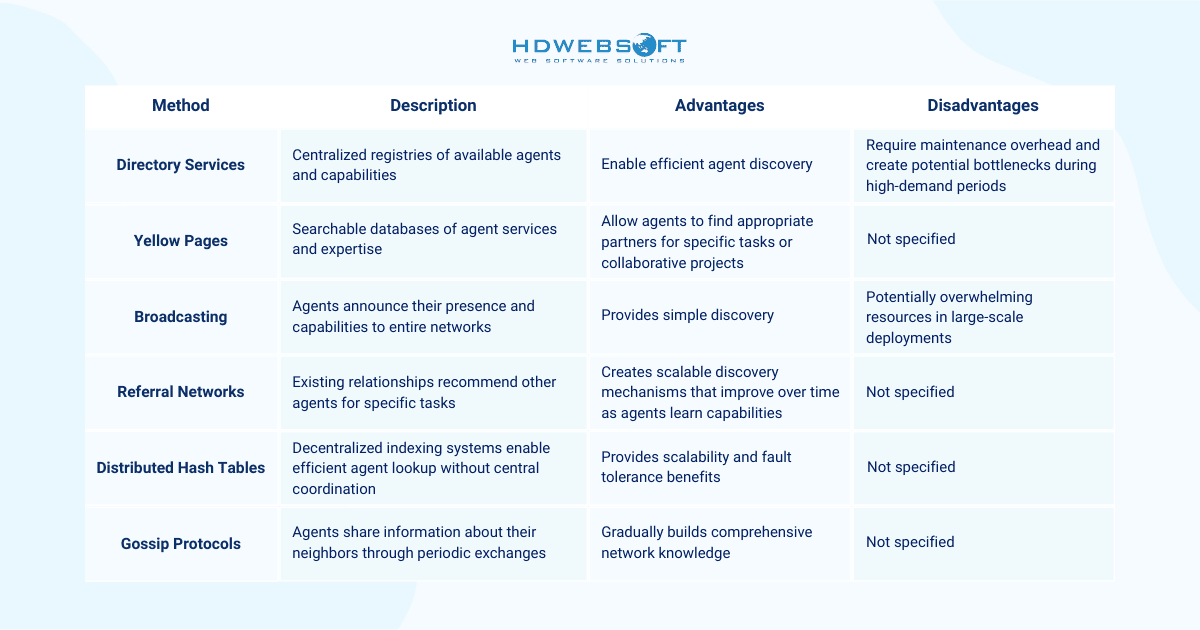
Error Handling and Fault Tolerance
In fact, multi-agent communication protocols must gracefully handle various failure scenarios that occur regularly in distributed systems. Comprehensive fault tolerance requires addressing multiple failure modes while maintaining acceptable performance under normal operating conditions.
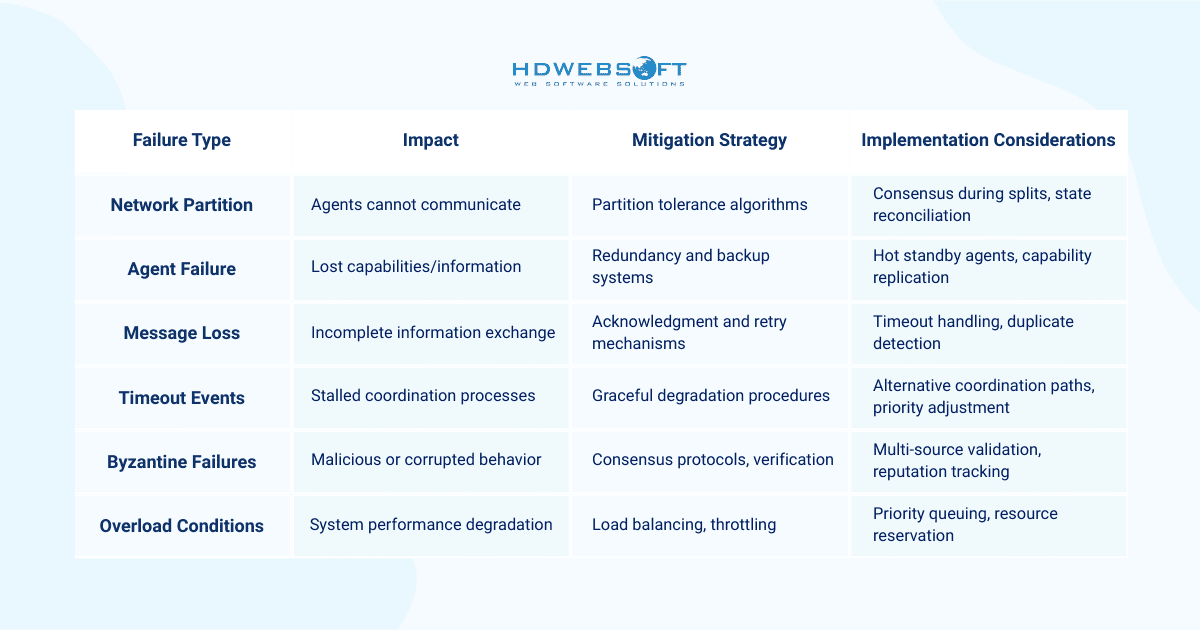
Security in Multi-Agent Communication Protocols
Protecting inter-process communication from security threats requires a comprehensive approach that addresses authentication, authorization, and data integrity.
Security in multi-agent communication requires comprehensive approaches addressing authentication, authorization, and data integrity. The following architecture illustrates how multiple security layers work together with trust-based systems to create protection for distributed agent networks.
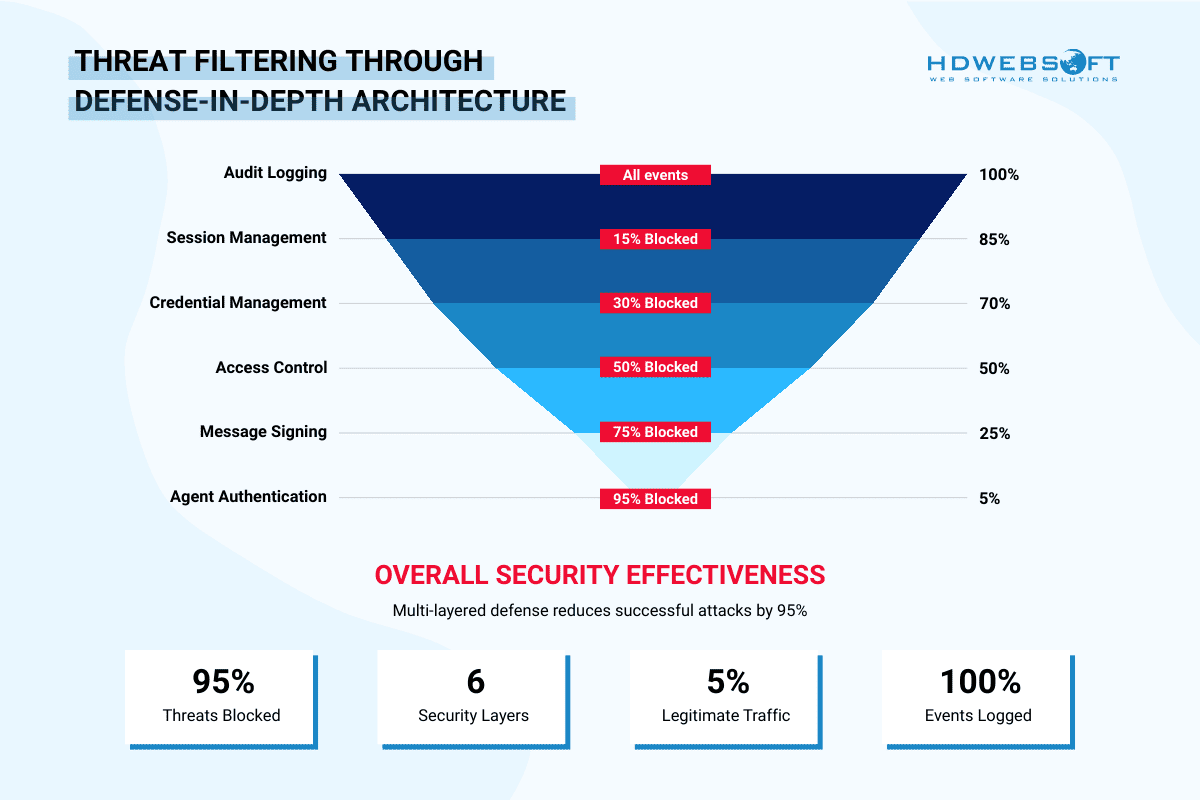
Trust Networks and Reputation Systems
Advanced agent coordination mechanisms incorporate trust and reputation to guide interaction decisions:
- Agents maintain reputation scores for their peers based on past interactions
- Trust networks enable transitive trust relationships between agents
- Reputation systems help identify and isolate malicious or unreliable agents
- Trust metrics influence partner selection for collaborative tasks
Performance Optimization
Optimizing multi-agent communication protocols requires balancing communication overhead with coordination effectiveness while maintaining system responsiveness and efficiency.
Message Compression and Bandwidth Management
Efficient communication strategies include:
- Message Batching: Combining multiple small messages into larger packets
- Data Compression: Reducing message size through compression algorithms
- Priority Queuing: Ensuring critical messages receive preferential treatment
- Bandwidth Throttling: Preventing any single agent from overwhelming the network
Coordination Overhead Reduction
Minimizing the computational cost of agent coordination mechanisms involves:
- Caching frequently requested information to reduce query overhead
- Using approximate algorithms when perfect coordination isn’t necessary
- Implementing lazy evaluation for coordination decisions
- Employing predictive models to anticipate coordination needs
This visual comparison demonstrates the dramatic improvements achieved through performance optimization techniques. The percentage improvements clearly show the ROI of implementing these optimization strategies.
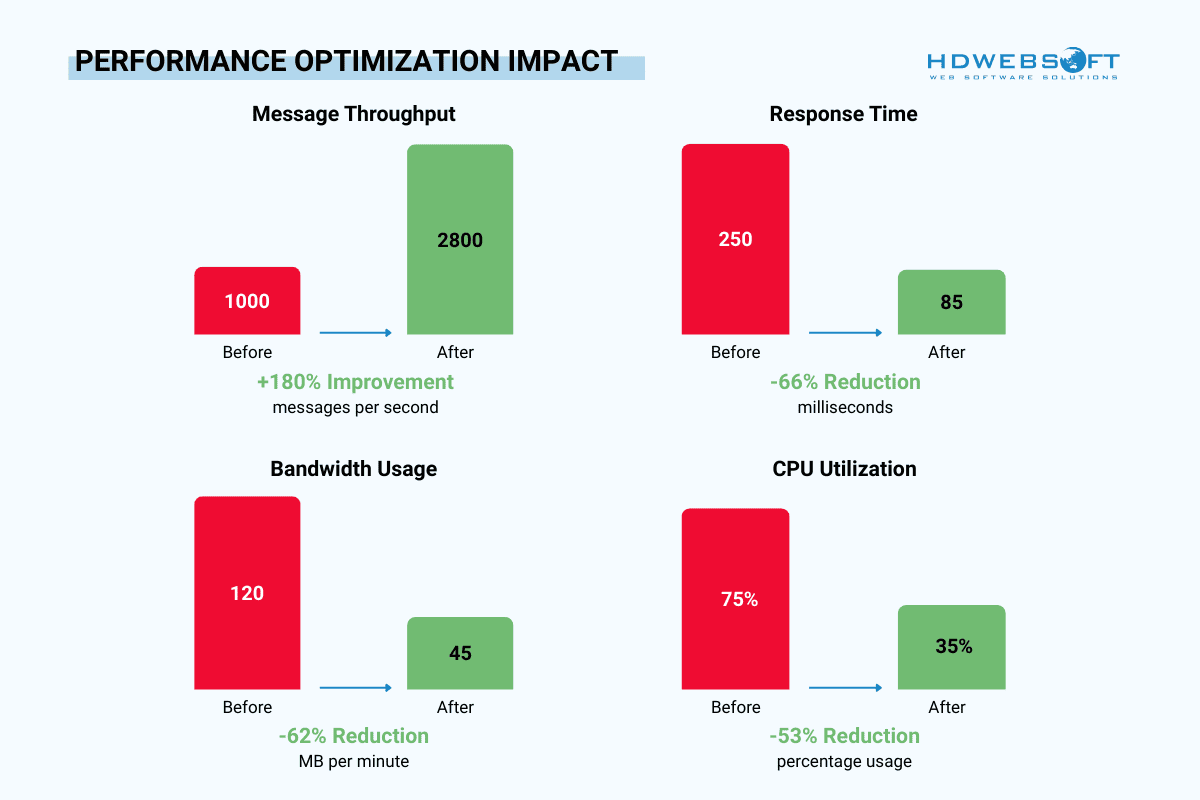
Best Practices and Implementation Guidelines
Successful implementation of the inter-communication process follows established best practices that ensure reliability, maintainability, and scalability.
Protocol Selection Criteria
Organizations should evaluate agent coordination mechanisms based on several key factors:
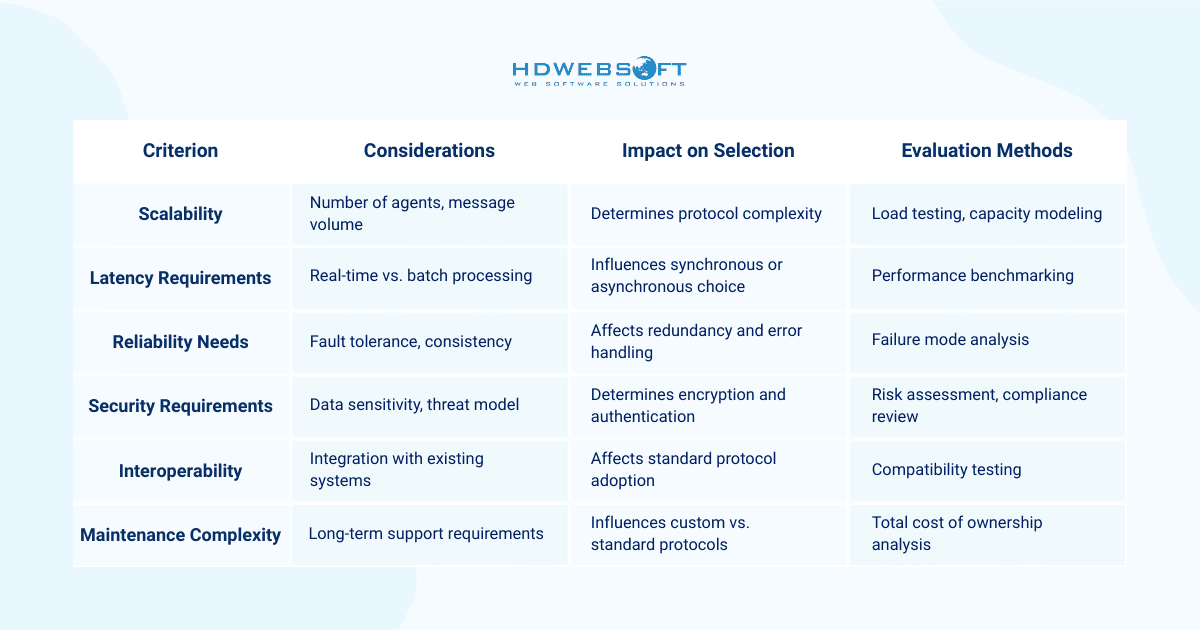
Testing and Validation Strategies
Thorough testing ensures multi-agent communication protocols perform correctly under various conditions:
- Unit Testing: Individual agent communication components
- Integration Testing: Multi-agent interaction scenarios
- Load Testing: System performance under high message volumes
- Chaos Testing: Behavior during network failures and agent crashes
- Security Testing: Resistance to attacks and malicious agents
Moreover, validation should include both functional correctness and non-functional properties like performance, security, and reliability.
Conclusion
Multi-agent communication protocols and agent coordination mechanisms form the essential foundation for building robust, scalable, and intelligent distributed systems. The evolution from simple message passing to sophisticated coordination strategies reflects the growing maturity of multi-agent technologies. Yet, successful deployment requires careful consideration of technical requirements, security implications, and performance characteristics to deliver significant business value.
If you’re wondering where to start, HDWEBSOFT specializes in developing cutting-edge AI solutions. Our experienced team helps organizations design, implement, and deploy intelligent agent networks tailored to their specific business needs. We ensure scalable architectures that integrate seamlessly with existing systems while maintaining the highest standards of security and performance.





